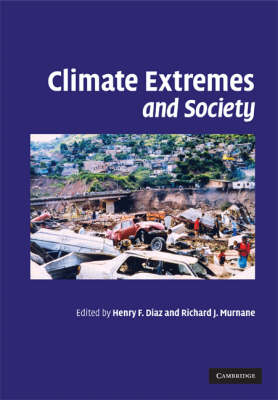
Climate Extremes and Society
Cambridge University Press (Verlag)
978-0-521-87028-3 (ISBN)
- Titel z.Zt. nicht lieferbar
- Versandkostenfrei innerhalb Deutschlands
- Auch auf Rechnung
- Verfügbarkeit in der Filiale vor Ort prüfen
- Artikel merken
Extreme climatic events present society with significant challenges in a rapidly warming world. Ordinary citizens, the insurance industry and governments are concerned about the apparent increase in the frequency of weather and climate events causing extreme, and in some instances, catastrophic, impacts. Climate Extremes and Society focuses on the recent and potential future consequences of weather and climate extremes for different socioeconomic sectors. The book also examines actions that may enable society to better respond to climate variability. It provides examples of the impact of climate and weather extremes on society. How have these extremes varied in the past, and how might they change in the future? What type of efforts will help society adapt to potential future changes in climate and weather extremes? The book is designed for all policy-makers, engineers and scientists who have an interest in the effects of climate extremes on society.
Dr Henry F. Diaz is a Research Meteorologist in the Earth System Research Laboratory at the National Oceanic and Atmospheric Administration (NOAA). He has worked on a variety of climate issues at NOAA over the last 15 years, particularly the impact of climatic variation on water resources of the western United States. He is recognized as an expert on the El Nino Southern Oscillation (ENSO) phenomenon and coedited El Nino: Historical and Paleoclimatic Aspects of the Southern Oscillation, also published by Cambridge University Press (1992). Dr Richard Murnane is the Program Manager for the Risk Prediction Initiative (RPI) and a Senior Research Scientist at the Bermuda Institute of Ocean Sciences (BIOS), where he leads RPI's efforts to transform science into knowledge for assessing risk from natural hazards. Dr Murnane's own research focuses on tropical cyclones, climate variability, and the global carbon cycle. Before joining the RPI and BIOS in 1997, Dr Murnane was on the research staff of Princeton University in the Program in Atmospheric and Oceanic Sciences.
Foreword R. S. Pulwarty; Preface H. F. Diaz and R. J. Murnane; Introduction H. F. Diaz and R. J. Murnane; Part I. Defining and Modeling the Nature of Weather and Climate Extremes: 1. Definition, diagnosis, and origin of extreme weather and climate events David Stephenson; 2. Observed changes in the global distribution of daily temperature and precipitation extremes David Easterling; 3. The spatial distribution of severe convective storms and an analysis of their secular changes Harold Brooks and Nikolai Dotzek; 4. Regional storm climate and related marine hazards in the Northeast Atlantic Hans von Storch and Ralf Weisse; 5. Extensive summer hot and cold extremes under current and possible future climatic conditions - Europe and North America Alexander Gershunov and Hervé Douville; 6. Beyond mean climate change - what climate models tell us about future climate extremes Claudia Tebaldi and Gerald A. Meehl; 7. Tropical cyclones and climate change - revisiting recent studies at GFDL Thomas R. Knutson and Robert E. Tuleya; Part II. Impacts of Weather and Climate Extremes: 8. Extreme climatic events and their impacts - examples from the European Alps Martin Beniston; 9. The impact of weather and climate extremes on coral growth M. James C. Crabbe, Emma L. L. Walker, David B. Stephenson; 10. Forecasting US insured hurricane losses Thomas H. Jagger, James B. Elsner and Mark A. Saunders; 11. Integrating hurricane loss models with climate models Charles Watson and Mark Johnson; 12. An exploration of trends in normalized weather-related catastrophe losses Stuart Miller, Robert Muir-Wood and Auguste Boissonnade; 13. An overview of the impact of climate change on the insurance industry Andrew Dlugolecki; 14. Toward a comprehensive loss inventory of weather and climate hazards Susan L. Cutter, Melanie Gall and Christopher T. Emrich; 15. The Catastrophe Modeling response to Hurricane Katrina Robert Muir-Wood and Patricia Grossi; 16. The Risk Prediction Initiative: a successful science-business partnership for analyzing natural hazard risk Richard J. Murnane and Anthony Knap; Index.
| Erscheint lt. Verlag | 22.5.2008 |
|---|---|
| Verlagsort | Cambridge |
| Sprache | englisch |
| Maße | 180 x 255 mm |
| Gewicht | 910 g |
| Themenwelt | Naturwissenschaften ► Biologie ► Ökologie / Naturschutz |
| Naturwissenschaften ► Geowissenschaften ► Meteorologie / Klimatologie | |
| Sozialwissenschaften ► Soziologie | |
| ISBN-10 | 0-521-87028-3 / 0521870283 |
| ISBN-13 | 978-0-521-87028-3 / 9780521870283 |
| Zustand | Neuware |
| Haben Sie eine Frage zum Produkt? |
aus dem Bereich


